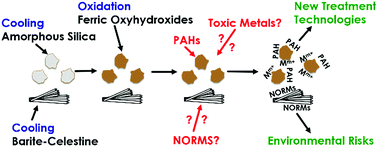Characterization and implications of solids associated with hydraulic fracturing flowback and produced water from the Duvernay Formation, Alberta, Canada†
Abstract
Public concern is heightened around flowback and produced water (FPW) generated by the hydraulic fracturing process. FPW is a complex mix of organic and inorganic solutes derived from both the injected hydraulic fracturing fluid and interactions with the subsurface lithology. Few studies to date have systematically investigated the composition of FPW or its individual components. Here, we provide the first systematic characterization of the composition of the solids associated with FPW by analyzing samples from three wells drilled into the Duvernay Formation in Alberta, Canada. The FPW initially returned to the surface with high total dissolved solids (greater than 170 000 mg L−1) and enriched with Fe(II), silica, sulfate, barium, and strontium. The solids form two distinct phases once the FPW reached the surface: (1) silica-enriched Fe(III) oxyhydroxides, and (2) a barite–celestine solid solution. We hypothesize that the precipitation of the amorphous silica-enriched Fe(III) oxyhydroxide is a two-step process, where first the silica precipitates as a function of the cooling of the FPW from elevated subsurface temperatures to ambient surface temperatures. Next, the silica acts as a template for the precipitation of Fe(III) oxyhydroxide as the diffusion of oxygen into the subsurface causes oxidation of aqueous Fe(II). The barite–celestine solid solution precipitates solely as a function of cooling. Elevated dissolved Fe concentrations in FPW and modeled saturation indices from five North American shale plays (Marcellus, Fayetteville, Barnett, Bakken, and Denver-Julesburg) indicate that solids similar to those found in Duvernay FPW, specifically Fe(III) oxyhydroxides, barite and quartz, are likely to occur. With the solids known to carry a significant portion of FPW's toxicity and organic contaminant load, the development of new treatment technologies, such as the oxidation of the Fe(II) in FPW, may increase FPW reuse and reduce the environmental risk posed by FPW.

- This article is part of the themed collection: The environmental geochemistry and biology of hydraulic fracturing


 Please wait while we load your content...
Please wait while we load your content...